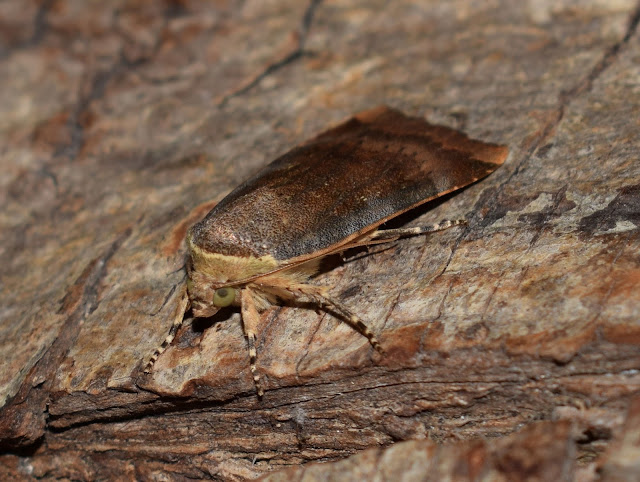Last session for August brought in seven species of Moth, two of which were new for the garden.
1. Old Lady *
2. Large Yellow Underwing (2)
3. Lesser Yellow Underwing
4. L-Album Wainscot
5. Common Quaker
6. Yellow Shell
7. Gold fringed Moth *
Old Lady Mormo maura
 |
| Old Lady Mormo maura |
First Old Lady for the garden was a nice surprise, usually flying between July and August, so fits nicely. also known as a Black underwing.
Said to frequent gardens and waste ground, hiding by day in old buildings and sheds.
Surprised by the size of this moth when seen flying around the light trap, large winged and sombre coloured.
So called because the pattern resembles the shawl worn by old ladies. Can't really see it myself though.
Gold Triangle Hypsopygia costalis
 |
| Gold Triangle Hypsopygia costalis |
Nearly missed this tiny micro moth, fairly common species in the south of the country. Flies in July to August and has a wingspan of 16-23mm
Apparently this moth has two resting positions, In one, the moth adopts a 'triangular' shape, with the hindwings hidden by the forewings, as in the photograph above.
At full rest, all four wings are splayed out, and the tip of the abdomen is tilted upward.
Other notable moths in the trap was this fine looking Yellow Shell
 |
| Yellow Shell |
 |
| Large Yellow Underwing |
 |
| Lesser Yellow Underwing |
Additions for August 2017
61. White-Point
62. Elbow-stripe Grass Veneer Moth
63. Old Lady
64. Gold Triangle
Not such a good catch this evening with just nine moths of 6 species, One new moth species for the garden in the form of a Elbow-Striped Grass Veneer moth.
1. Common Wainscot (2)
2. L-Album Wainsot
3. Common Quaker (3)
4. Light Brown Apple Moth
5. Tortrix species unknown
6. Elbow-Striped Grass Veneer
62 species now on the garden list
 |
| L-album Wainscot |
Elbow-Striped Grass Veneer
A common and widespread grass moth which flies between July to October, identification is made easier by the dark elbow shaped cross lines just visible on this photograph.
16th August 2017 " whats the point "
A good nights catch with at least 20 moths in the trap and one Jersey Tiger outside, a couple of Brimstone moths were fluttering around the trap late evening but managed to avoid the light trap.
A new Moth for the garden list in the form of this White-Point.
White-point Mythimna albipuncta
 |
| White-point Mythimna albipuncta |
My first thoughts on seeing this moth in the trap was to identify it as another Clay moth, a few of which have been caught in the garden earlier this year. but on closer inspection I have re-identified this as a White-Point , I hope correctly.
This moth is an immigrant to this country although it is now believed to breed here in the south and south east of the country. Seen in August to September.A single White Ermine moth was found in the trap, not as heavily marked as the previous male caught last month, I 'm pretty sure that this is a female, the abdomen was spotted with rows of black spots, although the wings are very sparsely spotted, these are suppose to be quite varied in appearance ,so nothing unusual there, the antenna as you can see in the photograph were not as feathered as last months leading me to conclude a probable female.
 |
| female White Ermine Spilosoma lubricipeda |
 |
| Spindle Ermine Yponomeuta cagnagella |
 |
| Straw Underwing Thalpophila matura |
A Setaceous Hebrew Character, just the one in the light trap, these fly between July and August, so right on schedule, this one seemed quite small.
 |
| Setaceous Hebrew Character Xestia c-nigrum |
Two Wainscots were in the trap one in good condition which I believe is a Common Wainscot, the other was in a very worn state and unidentifiable by me anyway.
 |
| Common Wainscot Mythimna pallens |
Three Lesser Broad Bordered Yellow Underwings in the trap giving me the opportunity to get a better record photograph of this species. quite an easy one to identify with its sharply defined pale buff frontal area, which gives a very neat appearance. these all appeared midway between its flight period of July to September.
 |
| Lesser Broad-bordered Yellow Underwing Noctua janthe |
Moths seen and caught during the evening included the following
Jersey Tiger 1, White ermine 1, Straw Under-wing 1, Lesser Broad Bordered Yellow Underwing 3, Setaceous Hebrew Character 1, Common Wainscot 2, Common Quaker 5, White Point 1, Spindle Ermine, Apple Moth 1, Brimstone 2.
11 species in all,
Additions for August 2017
61. White-Point
62. Elbow-stripe Grass Veneer Moth













No comments:
Post a Comment